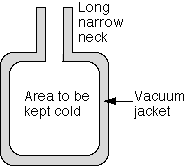- ACHE
- The ADR Control and Housekeeping Electronics,
which controls the Adiabatic Demagnetization Refrigerator.
- ADR
- The Adiabatic Demagnetization Refrigerator,
which keeps the detectors cold.
- Aliasing
- Aliasing is what happens when a signal is sampled (converted to
digital form) too slowly. Specifically, if a signal contains
frequencies above half the sampling rate, the sampled version of the
signal will have frequencies (aliases) that aren't in the
original signal. This limit of half the sampling rate is known as the
Nyquist limit.
For example, the CDP samples at 12288 Hz, so if the input signal
contains frequencies higher than 6144 Hz the digital signal will not
accurately represent the actual signal.
That is a rather incomplete description of aliasing. If you'd like
to learn more, the University of California at Santa Cruz has a
general
discussion of converting a signal to digital form.
- CAP
- The Calorimeter Analog Processor,
which provides power to the detectors and amplifies their signals
before passing them on to the CDP.
- CDP
- The Calorimeter Digital Processor, which digitizes and
processes the amplified voltage coming from the CAP.
- Cryogenic
- The use of extreme cold (within a few degrees of absolute zero).
Cryogenic systems often involve the use of
liquid helium (4 Kelvin) or liquid nitrogen (77 K). Astro-E
uses liquid helium and solid neon (17 K).
- dewar
 A
container used for cryogenic work, insulated by a vacuum space. Named after
Sir James Dewar(1842 - 1923). As shown in the drawing, the thermal insulation
is provided by a vacuum space. There is also a long neck to limit the heat
leaking in from the opening (or openings). The popular
Thermos® bottle works on this principle. A
container used for cryogenic work, insulated by a vacuum space. Named after
Sir James Dewar(1842 - 1923). As shown in the drawing, the thermal insulation
is provided by a vacuum space. There is also a long neck to limit the heat
leaking in from the opening (or openings). The popular
Thermos® bottle works on this principle.
There are three ways that heat can travel: convection, conduction, and radiation.
Conduction is what happens when you touch a cup of hot coffee; the heat flows from the hot
cup directly to your skin. Convection is when a section of hot liquid or gas moves
from one place to another. This happens in the air above your coffee -- a parcel of air just
above the hot coffee is heated by conduction, and then, because it's lighter, that
parcel rises, carrying heat by convection.
The third way for heat to travel is by radiation. This is what you feel when you
stand in the sunlight or near a hot fire.
In a dewar, the insulating material is a vacuum space. This eliminates conduction
(since there is no material to conduct the heat) and convection (since there is no
gas or liquid to convect). That leaves only radiation, which is stopped by covering the
insides of the vacuum space with reflective material, which reflects nearly all the
radiation before it enters the dewar.
The main XRS dewar contains solid
neon at 17 Kelvin (17°C.
above absolute zero). There is also a smaller dewar with 25 liters of
liquid helium at 1.3 Kelvin.
- Emission line
- A narrow peak in a spectrum caused by atoms emitting photons at a specific
energy.
- FEA
- The Front-End Assembly that holds the
detectors and first stage of amplifiers.
It is a part of the cryogenic insert.
- Insert
- This refers to the Goddard-built portion of XRS which is inserted into
the neon Dewar (which was built in Japan). The insert consists of the
Front-End Assembly, the Adiabatic Demagnetization Refrigerator, and a
25 liter Dewar of liquid helium.
- Kelvin
- A unit of temperature. A change of one Kelvin is the same as a change of
one degree Celsius (1.8° Fahrenheit),
but 0 Kelvin is absolute zero. Also, though people often use the term "degrees
Kelvin", the proper usage is just "Kelvin". Some sample temperatures:
| Kelvin |
°Celsius |
°Fahrenheit |
Notes |
| 0 |
-273.16 |
-459.69 |
Absolute zero |
| 273.16 |
0.0 |
32.0 |
Triple point of water |
| 373.16 |
100.0 |
212.0 |
Water boils |
- XRS
- The X-Ray Spectrometer, which is one of 3
instruments on board Astro-E.
|